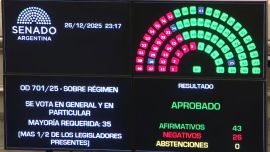Argentina, which has been battling a deep economic crisis since 2018, has unveiled a new debt repayment deal with the International Monetary Fund.
Here is a recap of recent turmoil.
Currency collapse
In April and May 2018, Argentina's peso loses nearly 20 percent of its value in 45 days. The Central Bank intervenes several times, hiking its benchmark interest rate to 40 percent and selling foreign currency reserves.
Massive IMF loan
In June, the IMF approves a US$50-billion bailout. President Mauricio Macri's government agrees to take austerity measures.
Strike, protests
Later that month, the country grinds to a halt in a general strike to protest the loan. In July and August, there are demonstrations over soaring inflation in Buenos Aires and other cities. In September, the government announces new austerity measures. Another major strike takes place in response.
Even bigger loan
The IMF agrees to boost its crisis loan package to US$57.1 billion, with US$44 billion eventually paid out. Argentina ends 2018 in recession. On April 4, 2019, tens of thousands of people protest against austerity. To limit inflation, the government freezes the price of basic goods and public services. The fifth general strike of Macri's presidency brings the country to a standstill on May 29.
Macri poll setback
In August, Macri loses a key primary election to Peronist leader Alberto Fernández. Macri announces minimum wage hikes, tax cuts and a freeze on fuel prices. Fitch and S&P downgrade Argentina's credit rating. In late August, Argentina asks the IMF to reschedule its debt.
Food emergency
On September 1, the government imposes exchange controls. On September 19, Congress adopts a food emergency law to allocate greater resources to social programmes.
Fernández president
Fernández wins the October presidential election. Argentina's Central Bank says it has sharply tightened currency exchange controls to temper capital flight. Fernández says that he will renounce the remaining US$13-billion tranche of Argentina's IMF loan as soon as he takes office in December. At his swearing in ceremony, Fernandez insists Argentina "wants to pay" its external debt but that it doesn't have "the means to do so."
'Selective default'
On December 20, the government postpones paying some US$9 billion, leading ratings agencies to downgrade its debt.
Emergency measures
On December 24, the government adopts a package of emergency measures. Inflation reaches 53.8 percent in 2019, while the economy shrinks by 2.1 percent.
Debt restructuring
In February 2020, the IMF says Argentina's debt is "not sustainable." In March, the government proposes to restructure US$68.8 billion of the US$311-billion public debt, which accounts for 90 percent of GDP. On April 6, Argentina defers payments of up to US$9.8 billion on its local public debt until 2021 in response to the coronavirus crisis. In mid-April, Fernández says his country has found itself in "a sort of virtual default."
New default
On May 22, Argentina defaults for the ninth time after failing to pay US$500 million of interest on its bond debt. Fitch and S&P reduce its credit rating.
Accord
In August, Argentina announces it has reached an agreement with three major creditors over the restructuring of a US$66-billion debt.
Discussions with IMF
Argentina then launches discussions with the IMF for a new financial programme. In 2020, Argentina's GDP contracts by nearly 10 percent.
Avoids default
In June 2021, Argentina reaches an agreement with the Paris Club of creditor countries to avoid defaulting on its loan repayments. On January 28, 2022 Argentina's president announces what he says is a "reasonable" accord with the IMF.






















Comments